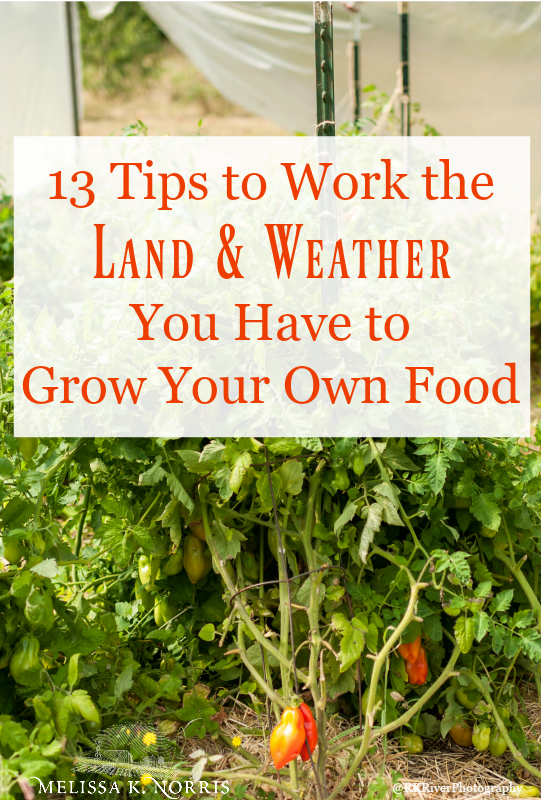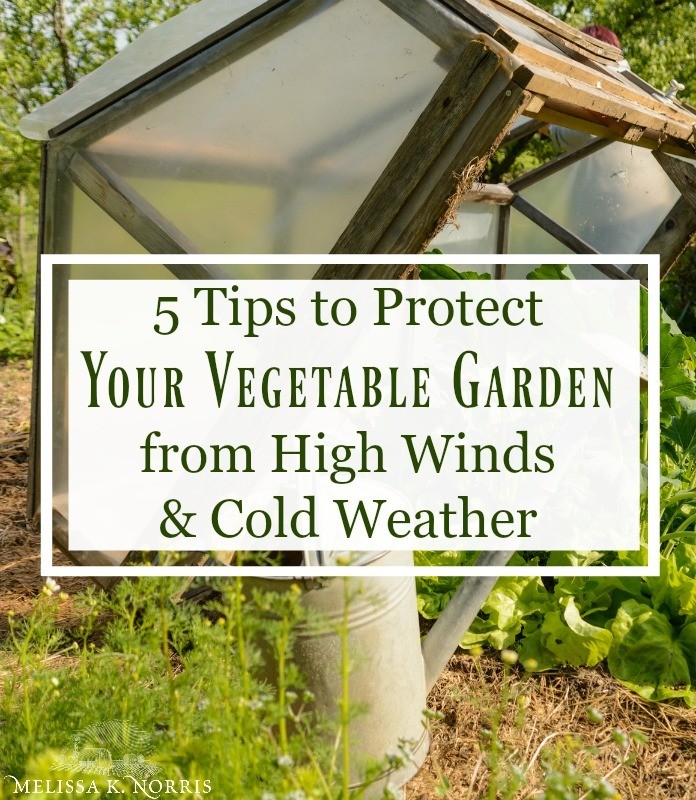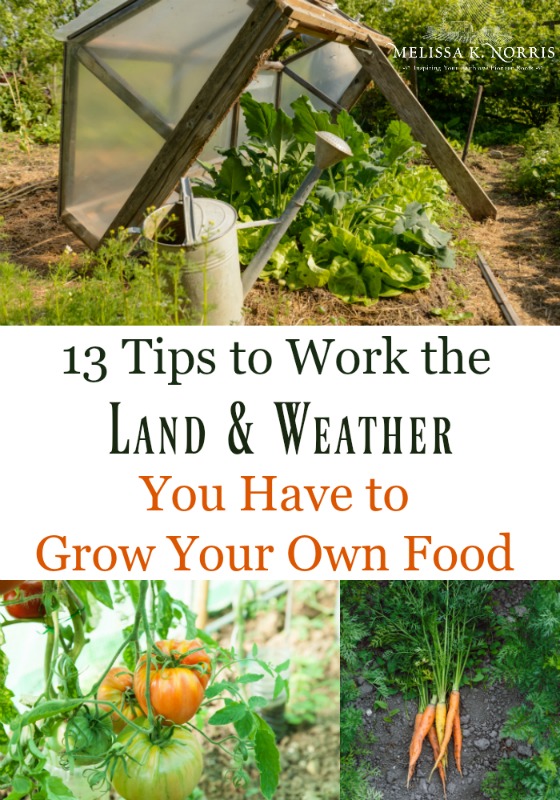If there’s one thing I’ve learned growing our own food, it’s that you cannot control the weather and no area is perfect for all foods. However, there are work arounds and things you can do to raise more of your own food, even with severe weather.
One thing about homesteaders, we know how to work with what you have, including less than desirable land and weather. On today’s episode of the podcast I have on long time gardener and self-sufficiency expert homesteader, Laurie Neverman of CommonSenseHome.com

We’ll talk about some of the things that have changed for us over the recent years; mainly, incremental weather, but some other things, and how we are combating them so that you can take that information and apply it to growing your own crops, as well.
Table of Contents[Hide][Show]
13 Tips to Work with the Land & Weather You Have to Grow Your Own Food
Listen below to Episode #140 of the Pioneering Today Podcast,where we teach families how to grow, preserve and cook their own food using old-fashioned skill sets and wisdom to create a natural self-sufficient home, with, or without, the homestead.
Laurie’s Homestead and Gardening Zone
Laurie: Our homestead is in Northeast Wisconsin, about 30 minutes from Green Bay. I think that’s the most commonly associated thing with Wisconsin for the rest of the country with the Green Bay Packers. We are gardening zone, officially, boarder line between 4 and 5, but if you look at the older hardiness maps, it was solidly zone 4. Because we’re out in the country, it’s more exposed and we get a lot of wind, which plays a big impact on our garden.
Typically if the year is, the weather’s cooperative, I can usually get in my crops around the end of May. Sometimes, in a good year, we might be able to sneak in the warm, heat-loving crops, say mid-May. Some people are as bold as to try it near Mother’s Day. I don’t normally do that ’cause I don’t feel that lucky.
I’ve seen snow on May 31st far too often. Sometimes we have to stretch it into June, and this year, I’m not quite sure what’s gonna happen because just on April 14th and 15th, we had a blizzard in the area that dumped nearly two feet of snow in Green Bay, and a little bit less than that near us, but we still got snow piles all over the place. It’s just crazy. I look out, the day’s are long, the sun is shining, but there’s snow everywhere. So it’s very weird gardening year.
Melissa: Do you have any early spring crops or some cooler crops that are in already, or had you really not put anything out yet?
Laurie: The weather was not really great, even before the blizzard. We still had frozen ground, and so I did not attempt to put anything out. Even the nights, where we’re seeing nights with lows in the single digits. So even the greenhouse wasn’t safe with those temperatures. ‘Cause we can get, maybe down in the lower 20s, and things will be okay, but because the greenhouse, one of them is attached to the house, and the other one has multi-wall polycarbonate, so it offers a little bit more frost protection, but once you get in the single digits, no. Everything’s pretty much toast at that point.
So, right now, I have the attached greenhouse crammed full of seedlings that are waiting for garden space, but the ground is still frozen, so I don’t know when I’m gonna be able to get stuff in.
The big greenhouse, the boys and I are gonna work that up, and I’m hoping that we can start planting things out there this week because our nighttime temps have now been closer to freezing, so, fingers crossed, we should be safe.
Gardening zones let you know approximately when, in the springtime, your last average frost date is and when your soil starts to warm up enough to put in those warm weather crops. In the fall, your first average frost date (because that usually signals the end of the summer) or the warm weather gardening season. And then, pretty much everything that you plant in and around in your garden, planting a spring garden, summer garden, fall crops, those all revolve around those frost dates and your gardening zone.

Even with Laurie being in Gardening zone 4 and our Gardening zone of 7b, both of us have the same plant out dates for warm weather crops.
How to Protect Your Vegetable Garden from High Winds
Laurie: We’re on a geological formation called the Niagara Escarpment, which is this raised ridge close to … sort of runs parallel to Lake Michigan, and if you drive up this area, you’ll notice there’s a lot of wind farms in the area. Turns out, we moved into some of the windiest spots in Wisconsin. Us and the wind turbans get blasted on a regular basis, which definitely makes an impact on your garden. Sometimes a big impact in the terms of what you plant.
5 Tips for Protecting Your Plants from Extreme Wind
- When you’re working with seedlings, you got your transplants that you’re putting out, make sure to, if at all possible, transplant them on a day that is a little less windy. It does happen, you can watch, so that if your schedule allows.
- Modified Windbreaks– For more tender crops, I’ll use modified windbreaks that I got from my husband’s great-uncle when he was remodeling, and I’ll but those blocking the prevailing winds, from the west or the north.
Put small windbreaks at ground level, set them down so that when my seedlings go out, they can have a little sheltered area to move into. - Use cold frames to block the wind. Sometimes the cold frames will be in the garden, and just the frames will sit there. I’ll take the covers off just to provide a wind block.
- Old milk or vinegar jugs. I’ll use those as a modified wall of water just protect and block that wind.
- Trellises. When the plants get larger, at the other end, any trellises that we use in the garden are deep, and they’re sturdy. I cannot use the typical box door, little flimsy trellises. They would be flat, and I’ve seen lots of neighbors like, “I tried that,” “Oh, they had those little wire trellises, and now their tomatoes are flat. That is not good.”
What to do if wind and rain have flattened your vegetable garden
And, another thing, if your plants do get flat, and if you get a particularly bad storm of high winds just otherwise, it’s surprising what plants can recover from. So, I’ve had heavy rains and high wind that year that flattened my corn crop, and if I get out there within 24 hours, pull the plants upright, stop the roots back into the ground, they will usually tend to recover and start growing upright again. So, you can improvise and do things to offer protection at all stages of growth cycles.
How to Grow Vegetables in Heavy Rain
Melissa: In order to grow your vegetables in heavy rain you’re going to need a few tricks up your gardening sleeve to make it work. Growing vegetables in the Pacific Northwest can be challenging, but we’ve found a few things that have made a big difference in our success and crop yields.
- Well draining soil. If you live in an area that gets a lot of rain or has heavy rain storms, having well draining soil is a must. Otherwise you’ll have swampy areas that will drown or rot the plants. It’s actually advantageous to have a little bit more sand in your soil and good organic matter to allow it to drain.
- Fungal and bacteria protection. Typically, the rainier weather brings cooler temps, couple this with constant moisture and our heat for me to be able to really successfully grow peppers and tomatoes where I’m not dealing with blight, we actually put up a … I call it a off-grade greenhouse, but it’s more a high tunnel because my tomatoes are planted down deep into the ground. I don’t heat it. We used an old carport frame, but it’s covered with the greenhouse plastic, and that is been the only way I have been able to successfully grow tomatoes without having any issues with blight or any fungal disease.
- Trellises or vertical gardening. Keeping plants up off the wet soil greatly helps with air flow and the reduction of fungal diseases. If possible, plant pole beans instead of bush and trellis plants that vine or sprawl, if possible.
Take a Tour of our High Tunnel in this video below and if you enjoy it, pop over to my YouTube channel for more and hit subscribe while you’re there
How to Increase Crop Yields When the Weather is Cold
Laurie: We initially started with just a very small attached greenhouse right off the southeast corner of our home, and then in 2015, we added a detached 10 by 20, multi-wall poly-carbonate greenhouse, and then in 2016/2017, we built an attached garden shed combination coop off the north side of that greenhouse, so that provides an additional block from the north winds to the greenhouse so it’s sheltered against that south side of the greenhouse.
With increasingly cold springs, add more protection via the form of high tunnels, hoops, or green houses.
This year, we’re planning to get another greenhouse. We’ve got one on order from Harvest Right. I told them, “Hold off on shipping because I cannot put in the ground because the ground is still frozen.” I’m going to be trying out one of their dome greenhouses, and these are kinda cool because they’ve got the stretch membrane that goes over the top and they lock together like tinker toys, and then they just have the anchors.
So, potentially, we could move that around the grounds if we decide we don’t want to keep it where we initially are putting it. And it will go up a lot faster than the multi-wall poly-carbonate kit, which is your typical hard frame, the panels that look sort of like corrugated cardboard except for translucent. That one was a complete pain in the backside to put up. So, we had a really interesting time building a funky foundation for that. For more info from Laurie on building a greenhouse foundation click here.
We ended up building sort of an inverted box frame mounted into posts that were sunk below the frost line, or just the fact that it worked out and it has held up now for several seasons. So, fingers crossed that it will continue to stay stable.
We’re gonna have greenhouse number three this season. We’re also tossing around the idea of trying to mount a bigger hoop house over the top of the existing greenhouse. Kind of push that season even a little bit farther. So, we’d have a greenhouse within a greenhouse.
The big hoop house would give X amount of time, but then the sheltered greenhouse within that would maybe give another month or two on the far end.
How much heat does an unheated greenhouse provide
If you’re not heating your greenhouse it will be approximately 5 to 7 degrees warmer than the outside air.
Melissa: this usually buys us about 2 weeks in the beginning of the gardening season and 2 weeks towards to the end for warm weather plants, meaning we can increase our growing time by about a month.
If you’re needing additional ways to protect your plants from frost you’ll find this article helpful Protecting Plants from Frost – 12 Ways to Beat the Cold Weather

How to Increase Tomato Harvest with Music
Laurie: Tomatoes like, well I talk about the different types of music they like, but what they found through testing is that plants respond to commonly to the morning bird song.
The dawn song of birds, they like those tonal qualities, and when the birds start singing in the morning, the tomatoes will open up their leaf openings, and they will drink in that morning dew. So, if you have a sound that mimics the morning bird song, that dawn song, and then you combine that with appropriate foliar fertilizers, then it dramatically can increase your harvest.
And sometimes they’ve even done it just with the music, not with the fertilizers, too, and had really great results. So, that was … I heard about that, I think it was in the Lost Language of Plants that was another really interesting book. They were even playing it say out in wheat fields and getting a 55% increase in production in comparison to the control field. Just from playing the right type of music at the right time.
How to Grow Crops in Really Hot Weather
Melissa: The past 3 to 4 years we’ve had unseasonably hot weather here in the Pacific Northwest. Normally, watering isn’t something we need to worry much about and we can grow cooler weather crops all summer.
- Use soaker hoses. Find soaker hoses here. A soaker hose allows the water to penetrate the soil (instead of running off) and uses a lot less water than an sprinkler. We started using soaker hoses to combat mildew and fungs with the tomatoes and peppers and I love them!
- Create shade barriers with other plants. Get strategic in your planting. I’m planting things like my lettuce and my spinach behind some of those larger trellis crops to provide some shade for them so it’s a little bit cooler in the heat of the afternoon.
For more info on Summer Gardening click here for Dealing with High Temperatures in the Garden



